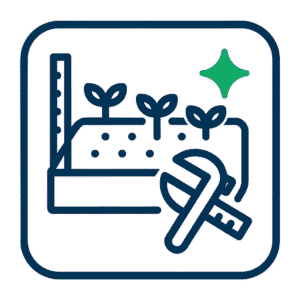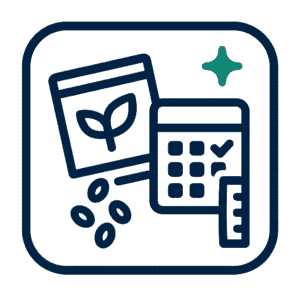Definitions and authoritative measures
Yield conventions matter when converting small-scale garden metrics into larger economic metrics. The U.S. Department of Agriculture’s reporting style states a clear operational definition: “Yield per acre: Total production divided by area harvested.” USDA NASS — Yield Forecasting Program.
Extension literature gives practical yield benchmarks for common home crops. For example, a University of Maryland guidance notes an “Approximate yield: 15 – 45 lbs. per 10-ft row” for typical home tomatoes. The same source records typical in-field spacing and days-to-maturity ranges that are useful when translating plant counts into expected harvest windows. University of Maryland Extension — Growing Tomatoes in a Home Garden.

Regionally focused yield tables condense historical performance into units that gardeners can apply directly. A Michigan State University production chart provides crop-level yields per 100 feet of row and per 100 square feet, allowing conversion between area-based layouts and expected pounds of produce. Those tables are a practical basis for the arithmetic below. Michigan State University — Vegetable Production Chart (Table 4).
Core methodology: convert area and plant count to estimated harvest
Three steps produce a reliable per-bed harvest estimate.
- Measure the planting surface in square feet.
- Determine plant count from spacing rules or from a planner (examples include using a garden spacing calculator for raised beds).
- Apply a per-plant or per-area yield factor from a vetted source (extension table, seed catalog datum or historical record). Multiply plant count by per-plant yield, or multiply bed area by yield per square foot. Cite the data source for traceability.
Example formulas:
- Plants per bed = Bed area ÷ Area per plant (where area per plant = spacing × spacing for square grids).
- Estimated harvest (lbs) = Plants per bed × Expected lbs per plant.
- If a table gives yield per 100 ft of row, convert bed area to equivalent row feet and scale accordingly. Use rounding conservatively: round down plant counts only when access or trellising requires it, and round up yield projections slightly to provide a buffer for operational planning.
For seed handling and emergence rates, follow extension practice. The University of Minnesota advises: “Sow two to three seeds in each tray cell or peat pot. Make a one-fourth to one-half-inch hole using a dibble tool or pencil with a tape mark to keep the depth consistent.” That practice reduces re-sowing and the need for later thinning, which affects final plant counts and therefore yield estimates. University of Minnesota Extension — Planting the Vegetable Garden.
Worked example: a typical raised bed
A common raised bed is 4 ft × 8 ft (32 ft²). Suppose the chosen crop is a slicing tomato with 18–36 in recommended spacing and an average yield guidance of 10–15 lb per plant from several extension sources.
– Use a conservative 24 in (2 ft) centre spacing for a grid. Area per plant = 2 ft × 2 ft = 4 ft².
– Plants per bed = 32 ft² ÷ 4 ft² = 8 plants.
– If expected yield is 10–15 lb per plant, bed harvest estimate = 8 × 10–15 = 80–120 lb. Cross-check with area-based tables (for instance, MSU yields per 100 ft of row or Harvest to Table per-10-ft-row figures) to confirm that the plant-based estimate is consistent with historical data. The University of Maryland’s tomato estimate, “15 – 45 lbs. per 10-ft row,” provides a secondary sanity check when plotting rows instead of grids. Harvest to Table — Vegetable Crop Yields, Plants Per Person Estimator.
Scaling and variance: sources of error and modifiers
Several factors modify the base estimate:
- Germination and transplant survival rates. Use the seed-starting guidance above and adjust plant counts by expected survival percentage (for many home crops 80–95 percent is reasonable if transplants are healthy).
- Planting geometry and trellising. Vertical training increases yield per unit ground area by improving light interception and air flow; compare grid and trellis scenarios with a garden spacing calculator for raised beds.
- Soil fertility and water management. Charts in extension literature link fertiliser regimes and irrigation frequency to realized yields; a watering schedule by plant type should be matched to the rooting volume provided by the chosen bed depth and soil mix.
- Local climate. Use a frost date calculator for gardeners to set planting windows and to decide whether succession sowings are practical; days-to-maturity values on seed packets are a key input when users wish to calculate harvest dates by planting in a specific year.
From yield to monetary value
Estimating gross production is a prerequisite to valuing output. Local wholesale or retail prices are the natural multiplier. For domestic home-economy valuation, compare the estimated harvest weight against local retail prices for the same commodity and adjust for quality and storage loss.
Example process:
- Estimate total bed yield in pounds.
- Subtract post-harvest loss (typical home-storage loss differs by crop; conservative planning often reserves 5–15 percent for handling and short-term spoilage).
- Multiply by local price per pound for retail valuation, or apply wholesale farmgate prices for commercial planning. Use recent USDA price series or local market reports for timely price inputs. USDA ERS — Fruit and Vegetable Prices.
Tools and integration
A practical yield workflow links layout and spacing tools with calendar and harvest calculators:
- Use a garden spacing calculator for raised beds to convert spacing rules into plant counts quickly. Many planners include companion-planting layers; a companion planting planner online can flag positive or negative pairings that affect yield.
- Use a frost date calculator for gardeners and the seed packet’s days-to-maturity figure to calculate harvest dates by planting; online harvest date calculators automate the arithmetic.
- Maintain a seed sowing schedule per climate so that transplants and direct sown crops reach productive stages in sequence and reduce labour peaks. Extension guides and planners can export calendars for this purpose.
Risk mitigation and sensitivity
Yield forecasts should include sensitivity analysis. Small-scale scenarios can be stress-tested by adjusting germination, survival and per-plant yield variables by plausible percentages (±10–25 percent) to produce minimum-expected and best-expected harvest bands. When planning storage and market sales, use the minimum band for conservative order planning and the best-expected band for opportunistic sales.
Institutional advisory text underlines the linkage between timing and outcome: consistent sowing and transplant timing shorten the variance between expected and realized yields. Appropriate seed depth and spacing guide adherence reduces early losses due to poor emergence and overcrowding. MSU production tables are useful for converting between area-based yields and per-plant metrics.
Operational checklist
- Record bed dimensions and compute area.
- Choose planting geometry and compute required plant counts.
- Source per-plant or per-area yield factors from extension tables (for example MSU, Harvest to Table) or from trusted historical data.
- Adjust counts for expected germination and survival.
- Create a seed sowing schedule per climate and synchronize it with a frost date calculator for gardeners and the best sowing dates for my zone.
- Translate harvest weight to economic value using current local prices and include handling/storage loss allowances.
- Record realized yields and adjust yield factors for future planning.
Final Considerations
Yield estimation converts horticultural practice into repeatable financial planning. Use authoritative yield tables and extension guidance for baseline factors, and link those figures to plant counts derived either from direct spacing arithmetic or from a garden spacing calculator for raised beds. Seed-starting rules such as “Sow two to three seeds in each tray cell or peat pot. Make a one-fourth to one-half-inch hole” reduce re-sowing and support more accurate plant counts, which in turn improve harvest forecasts. Apply simple sensitivity analysis to capture uncertainty, and integrate harvest date calculators and a watering schedule by plant type so that irrigation capacity and harvest timing align with expected output. Realized yield records complete the feedback loop and refine future estimates.






